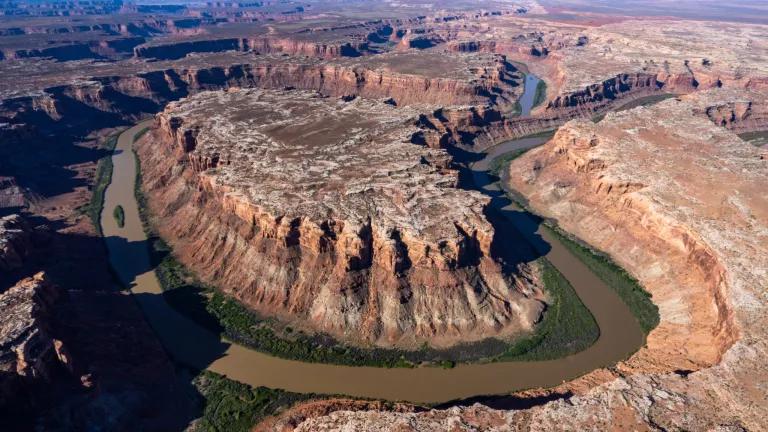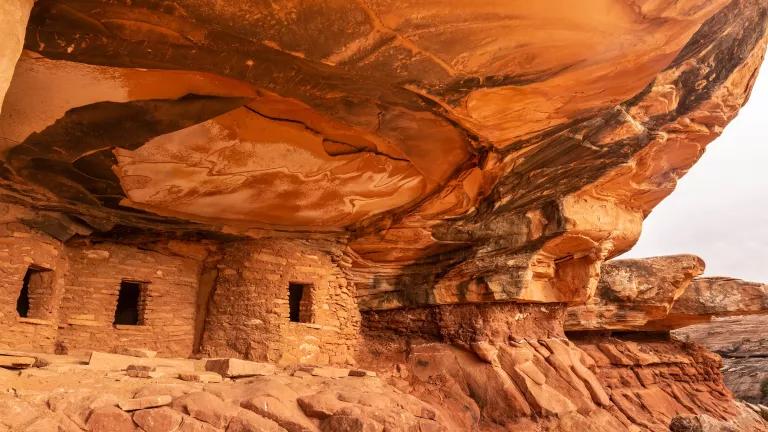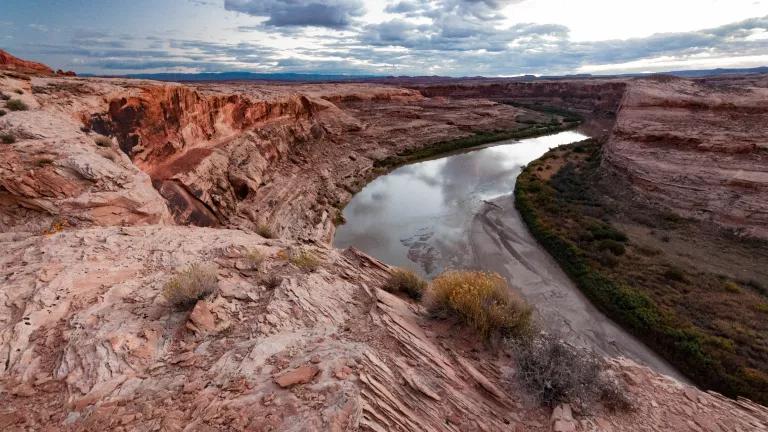Judge Halts Action on Utah Helium Drilling
NRDC and partners today headed off an attempt by the Trump administration to rush approvals for new helium drilling operations within one of America’s newest and most iconic wilderness areas: Labyrinth Canyon in southeastern Utah. This is part of a broader eleventh hour attack on our bedrock environmental protections before Trump’s term ends.

Bowknot Bend, Labyrinth Canyon (lease area located at upper right).
NRDC and partners today headed off an attempt by the Trump administration to rush approvals for new helium drilling operations within one of America’s newest and most iconic wilderness areas: Labyrinth Canyon in southeastern Utah. This is part of a broader eleventh hour attack on our bedrock environmental protections before Trump’s term ends.
On December 14, NRDC and co-plaintiffs led by the Southern Utah Wilderness Alliance (SUWA), filed a lawsuit in federal court arguing that the Bureau of Land Management violated the National Environmental Policy Act (NEPA) by failing to appropriately analyze the potential environmental impacts of its leasing decision or justify its action in offering the lease in the first place. Three days later, we filed a motion seeking an emergency injunction to stop any project approvals. Today, in a hearing less than 24 hours before the Bureau intended to approve the project, federal district court Judge Rudolph Contreras of the U.S. District Court for the District of Columbia enjoined the project from proceeding until at least January 6.
The story of how we got to this point is one for the books.
For at least 20 years, local advocates and tribes in the region around Labyrinth Canyon have sought permanent protection for the 55,000 acres of the Labyrinth Canyon Wilderness. Even if you’ve never been to the area, there is a good chance you’ve seen pictures. The wilderness borders the Green River and includes the iconic Bowknot Bend—a deep, red rock river canyon where the river turns 180 degrees and forms a deep, colorful U in the landscape.
In late 2018, Congress got involved in the effort to protect this astonishing river canyon, assembling the John D. Dingell, Jr. Conservation, Management, and Recreation Act (the Dingell Act), an enormous package of conservation-focused bills. Despite clear indications that Congress intended to protect Labyrinth Canyon with the Dingell Act, the Bureau of Land Management went ahead and included a 1,410-acre parcel in its plans for a December 2018 oil and gas lease sale. In short: it set about leasing a parcel located completely within what was soon to become a designated wilderness area.
The Dingell Act passed Congress on February 26, 2019. Three days later, the Bureau of Land Management issued a lease to Twin Bridges Resources, a company seeking to drill up to seven wells to produce helium gas. On March 12, President Trump signed the Dingell Act into law, officially designating Labyrinth Canyon as wilderness. But under the law, the Bureau’s move in issuing Twin Bridges’ its lease before March 12 potentially preserved its right to develop the lease pending the Bureau’s future approval of the project proposal.
The Bureau’s nefarious actions are in full display as Trump’s presidency wanes. It is working overtime to approve drilling, just days before Christmas, after a shortened comment period on its environmental assessment of the Twin Bridges proposal closed on November 9, 2020. The timeframe created high drama. If the Bureau had issued its approvals as it intended (tomorrow), the company would have immediately moved to widen roads at the very edge of the wilderness, dig pipeline ditches, bulldoze well pads, and move in drilling rigs up to 150 feet high. And all of that would cause permanent damage to lands visible for miles from within the Labyrinth Canyon Wilderness.
This entire saga originated with President Trump’s slew of executive orders setting forth an “energy dominance” agenda—an agenda that has driven economically wasteful and environmentally harmful oil and gas leasing to unprecedented levels.
Here’s hoping Twin Bridges will be stopped permanently. And we’ll certainly be hard at work in the New Year to ensure that iconic and pristine landscapes like this one remain permanently protected from unnecessary and harmful development.




